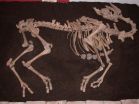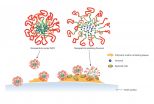Computer model predicts how our livers will store fat
Computer model developed to predict how 'T09' causes the liver to store fat could be used to predict liver fat storage for other drugs and conditions
2015-04-01
(Press-News.org) As part of an effort to understand how an experimental drug for atherosclerosis causes the build-up of fat in the liver, scientists have developed a computer model that can predict how the rate at which liver stores fat in response to various situations. Being able to model liver fat storage gives researchers a way to predict the side effects of drugs and environmental factors at much earlier stages in the research and drug development process, possibly reducing the number of experiments involving animal models. Additionally, this computer simulation helps describe all of the possible ways in which the liver stores fat, including how the liver takes up or creates fats and how it disposes of fat. This knowledge could lay the foundation for future research regarding the liver and its functions. This was published in the April 2015 issue of The FASEB Journal.
"Because our computer model can predict how the body responds to a drug over time, it will help to understand and treat diseases in humans and how to develop new drugs with less side effects," said Maaike Oosterveer, Ph.D., a researcher involved in the work from the Department of Pediatrics and Laboratory Medicine at the University Medical Center Groningen in Groningen, Netherlands.
To develop their computer model, Oosterveer and colleagues studied four groups of mice. One group received no treatment at all, while the other three groups were treated with the experimental drug called "T09" for either 1, 7 or 14 days. In each of the four groups, researchers measured several ways in which the liver becomes fatty. These measurements led to the development of the computer model. They then used the model to predict how the ways of fat storage that were not measured in the mice contributed to a fatty liver in the animals receiving the drug, and it provided clues about the how the drug leads to fat storage over time. It predicted that after just one day of drug treatment, more fat is flowing from the bloodstream into the liver. Performing a new experiment in mice confirmed this prediction.
"It's only a matter of time before computers are able to model every system, every disease and every cell in our body," said Gerald Weissmann, M.D., Editor-in-Chief of The FASEB Journal. "This computer model is an important early step toward a future where computers make disease research and drug development much more efficient than it is today."
INFORMATION:
Receive monthly highlights from The FASEB Journal by e-mail. Sign up at http://www.faseb.org/fjupdate.aspx. The FASEB Journal is published by the Federation of the American Societies for Experimental Biology (FASEB). It is the world's most cited biology journal according to the Institute for Scientific Information and has been recognized by the Special Libraries Association as one of the top 100 most influential biomedical journals of the past century.
FASEB is composed of 27 societies with more than 120,000 members, making it the largest coalition of biomedical research associations in the United States. Our mission is to advance health and welfare by promoting progress and education in biological and biomedical sciences through service to our member societies and collaborative advocacy.
Details: Brenda S. Hijmans, Christian A. Tiemann, Aldo Grefhorst, Marije Boesjes, Theo H. van Dijk, Uwe J. F. Tietge, Folkert Kuipers, Natal A. W. van Riel, Albert K. Groen, and Maaike H. Oosterveer. A systems biology approach reveals the physiological origin of hepatic steatosis induced by liver X receptor activation. FASEB J. April 2015 29:1153-1164; doi:10.1096/fj.14-254656 ; http://www.fasebj.org/content/29/4/1153.abstract
ELSE PRESS RELEASES FROM THIS DATE:
2015-04-01
While testosterone replacement therapies may be controversial in males, new research in The FASEB Journal may extend this controversy to females too. That's because research involving mice, appearing in the April 2015 issue, suggests that there is an association between low levels of androgens (which includes testosterone), and atherosclerosis and obesity in females.
"We hope that our study will contribute to intensified research efforts on the definition of androgen deficiency in women (e.g. which levels of androgens in the blood should be considered too low?), the ...
2015-04-01
Jacksonville, Fla. (April 1, 2015) - Training pediatric primary care providers to screen and assess depression and suicide risk in adolescent patients improved providers' confidence and knowledge of these conditions and increased frequency of screenings for this critical patient population. The study, published in the May/June issue of Academic Pediatrics, demonstrates an effective tool for improving recognition of adolescent depression.
"Adolescent depression is woefully underrecognized and undertreated," said Elise Fallucco, MD, a lead author of the study and child ...
2015-04-01
The name sounds like something Marvin the Martian might have built, but the "nanomechanical plasmonic phase modulator" is not a doomsday device. Developed by a team of government and university researchers, including physicists from the National Institute of Standards and Technology (NIST), the innovation harnesses tiny electron waves called plasmons. It's a step towards enabling computers to process information hundreds of times faster than today's machines.
Computers currently shuttle information around using electricity traveling down nanoscale metal wires. Although ...
2015-04-01
Annapolis, Md -- New research published today in Nature Communications provides insight into how large-scale deforestation could impact global food production by triggering changes in local climate. In the study, researchers from the United States and China zero in on albedo (the amount of the sun's radiation reflected from Earth's surface) and evapotranspiration (the transport of water into the atmosphere from soil, vegetation, and other surfaces) as the primary drivers of changes in local temperature.
The research is the first global analysis of the effects of forest ...
2015-04-01
If you want the benefits of medical marijuana without the "unwanted side effects" of cannabis, new research should leave you on a high note. According to a research report appearing in the April 2015 issue of The FASEB Journal, fenofibrate, also known by the brand name Tricor®, may benefit a wide range of health issues, such as pain, appetite stimulation, nausea, as well as immune and various psychiatric and neurological conditions. This suggests that fenofibrate may be the starting point for a new class of cannabis-like drugs to treat these types of conditions.
"By ...
2015-04-01
The Pacific Northwest is dotted by small, low-lying, coastal cities where populations tend to cluster. These communities can be isolated and are susceptible to devastation from major storms that bring substantial wind, waves and storm surge. With climate change, it is anticipated that storms will only become more frequent and intense, signifying a need to understand how the areas will be affected.
David Hill, a researcher at Oregon State University, is focused on the hydrology and hydrodynamics in coastal areas, which represent the boundary between terrestrial and marine ...
2015-04-01
PHILADELPHIA-- Penn Medicine researchers are continuing their work in trying to understand the mechanisms through which anesthetics work to elicit the response that puts millions of Americans to sleep for surgeries each day. Their most recent study looked at ketamine, an anesthetic discovered in the 1960s and more recently prescribed as an anti-depressant at low doses. Through collaboration with the University of Pennsylvania's department of Chemistry and scientists at the Duke University Medical Center, researchers at Penn's Perelman School of Medicine have identified ...
2015-04-01
ALEXANDRIA, VA -- An updated clinical practice guideline from the American Academy of Otolaryngology--Head and Neck Surgery Foundation published today in Otolaryngology-Head and Neck Surgery identifies quality improvement opportunities and explicit actionable recommendations for clinicians managing adult sinusitis, including a greater focus on patient education and patient preference.
"More than ever before, there is a prominent role for shared decision-making between patients and clinicians when managing adult sinusitis--especially in deciding whether to use antibiotics ...
2015-04-01
In 2006 construction began on a new shopping centre in Tulln. The works unearthed various archaeologically valuable objects that were salvaged during rescue excavations. Among these objects was also the complete skeleton of a large mammal.
Large mammal uncovered during excavations in Tulln
"The partly excavated skeleton was at first suspected to be a large horse or cattle," says archaeozoologist Alfred Galik from the Institute for Anatomy, Histology and Embryology at the University of Veterinary Medicine Vienna. "But one look at the cervical vertebrae, the lower jaw ...
2015-04-01
Therapeutic agents intended to reduce dental plaque and prevent tooth decay are often removed by saliva and the act of swallowing before they can take effect. But a team of researchers has developed a way to keep the drugs from being washed away.
Dental plaque is made up of bacteria enmeshed in a sticky matrix of polymers--a polymeric matrix--that is firmly attached to teeth. The researchers, led by Danielle Benoit at the University of Rochester and Hyun Koo at the University of Pennsylvania's School of Dental Medicine, found a new way to deliver an antibacterial agent ...
LAST 30 PRESS RELEASES:
[Press-News.org] Computer model predicts how our livers will store fat
Computer model developed to predict how 'T09' causes the liver to store fat could be used to predict liver fat storage for other drugs and conditions



